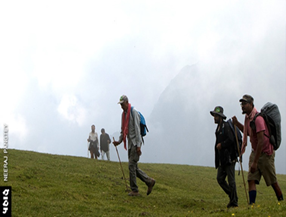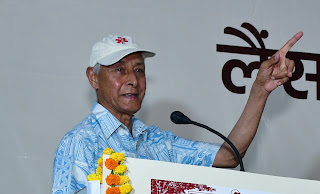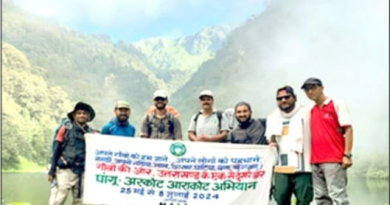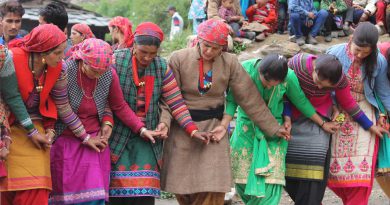Shekhar Pathak Leads 6th ASKOT – AARKOT Expedition
The famous lines of the poet ‘Iqbal’ from his ‘Tarana e Hind’ come to mind and sound so ‘ironical’ as time has come for us to protect the ‘Himalayas’! The Mighty Mountains which have beckoned Adi Shankaracharya, Swami Vivekanand, numerous saints, scientists, colonists, activists and commoners are inseparable part of our existence and identity :
“Parbat wo sabse ooncha
Humsaya Aasman ka
Wo Santari Hamara
Wo Paasban Hamara”
( Mountain so high
So that it meets the sky!
It is our Sentry!
It is our protector!)
Shekhar Pathak, historian , environmentalist , founding editor of the annual journal ‘Pahad’ (since 1983) , is leading and guiding the ‘6th Askot to Arkot expedition’ in the Uttarakhand hills . Askot is at the east end of the state in Pithoragarh district adjoining Nepal and Aarkot is at the west end in Uttarkashi district adjoining Himanchal Pradesh. A distance of about 1150 km is being covered in about 45 days from 25 May to 08 July 2024.
The first ‘Askot-Aarkot expedition’ started in 1974 on 25 May on the birthday of Shridev Suman the great freedom fighter of Tehri Garhwal who died in jail in 1944 after observing 84 days of hunger strike. The motivation of Yatra was accorded by late Sundar Lal Bahuguna, one of the prominent leaders of the ‘Chipko movement’ . The students of the newly opened Garhwal and Kumaon Universities participated . Since then expeditions have been undertaken after every 10 years . The expedition motto is:
‘ Apne gaavon ko hum jaane
Apne logon ko pehchane.
Talon , gallon – bugyalon ke sang
Apni nadiyon ko bhi samzhen.’
( we shall know our villages
understand our people
along with lakes, glaciers, alpine pasture lands
Also assess our rivers )
Therefore the objectives are to know the people and the environment. What is creditable is that this contact and study programme which commenced in 1974 shall be completing 50 years in 2024! Many members of the of the expedition would have covered these villages and people earlier too.
Over the years other organizations and students from various universities joined the expedition and other mountain states were also explored . The year 2014 expedition was flagged off by Shri Chandi Prasad Bhatt another great leader of Chipko movement for which he was honoured with Magsaysay award. He named the expedition –‘ Jangam Vishwavidyalaya’. Research students from America , Canada , Germany and eight Indian states were part of the team of about 200 personnel.
This year the theme is – ‘ Strot se sangam’ ( from source to confluence) concentrating on rivers of Uttarakhand. Other subjects of study include- destruction caused by mining, dam construction , road construction , the state of Dalit and minority communities , socio – political awareness, economic and cultural interventions, the increase in migration, the changes which have occurred in villages. Two way communication is conducted, it is a learning experience for the team members too . The state shall be completing 25 years shortly and the team would delve in the aspects of progress in these years.
This year the group consists of workers of various organizations, students from universities from all over India, students from colleges of Uttarakhand and Himanchal Pradesh , journalists , writers, artists, scientists, social scientists , socio- political workers, other Himalayan lovers of the country. Expedition shall be undertaken by various groups embarking on various routes.
In order to make the expedition more purposeful some historical routes undertaken by ancient and modern travellers have been added such as that of Huen Swing’s 7th century Travel. Some routes of Pandit Nain Singh Rawat’s famous expedition and that of Swami Vivekanand have also been included.
The expedition shall cross 7 districts of Uttarakhand- Pithoragarh, Bageshwar, , Chamoli, Rudra Prayag, Tehri Garhwal, Uttarkashi and Dehradun.
The journey shall cover 350 villages, 35 rivers, 16 ‘Bugyals’ ( alpine pastures), 15 earthquake and landslide affected areas , 15 Chattis (deserted resting/shelter stations ), 8 areas of Chipko movement, 5 tribal areas, 5 pilgrim routes, 3 Indo- Tibetan routes and shall commence from Pangu-Aarkot in Pithoragarh and culminate at Askot in district Uttarkashi. At the end of the journey participants shall be sharing their experiences and a conference is being planned
What is the significance of this expedition in addition to above, specially for the young citizens? In times when the tourists flock to hills during summer in their motor cars and clog the roads and Hotels , it is motivation for the young to move on foot . The tradition of making journey on foot was prevalent in hills since ages by pilgrims from near and far. The char-Dham yatra which is so popular from May to November is now undertaken by road on motor vehicles . But, once there was a regular walking route from Rishikesh to Kedarnath and Badrinath and pilgrims moved on foot for months on the designated route. The same needs to be revived by the tourism department in order to instil the true spirit of the devotional journey, adventure , contact with people . It is encouraging to learn that this ‘ancient route’ was rediscovered by Lokesh Ohri ,Anthropologist and cultural activist based in Dehradun and his team and they covered the 438 km route in 10 days in January 2016, rediscovering many chattis ( resting places)and caves for shelter on the way. The same was reported in ‘Times of India Dehradun’ of 19 February 2016. The report also laments that the mistakes brought out after the Kedarnath disaster of 2013 have not been adhered to and still construction is being done along the road and bridges are being constructed where avoidable.
Shri Jai Singh Rawat senior journalist of Uttarakhand has brought out in his article titled ‘Dhare reh gaye Kedarnath aapda ke sabak’ ( lessons of Kedarnath tragedy left aside) published in Hindi ‘Daily Tribune’ 0n 18 June 2024 that up-to 16 June in mere one month and six days of ‘Chardham Yatra’ 2,58,957 vehicles reached ‘Gau mukh’ near by glaciers, ‘Badri -Kedar’ and ‘Yamnotri’ which causes melting of glaciers and increase in mountain lake areas and numbers . The total tourists in the four shrines reached to 23,54,440 up-to 16 June whereas up-to the year 2000 in six months also less tourists visited. Jai Singh states that according to recent assessment of ISRO among 147 landslide sensitive areas districts ‘Rudra Prayag and ‘Tehri’ of Uttarakhand are at no 1 and 2 position respectively and all 13 districts of Uttarakhand are in the list .
Traditionally when people undertook the long and arduous pilgrimage the journey which entailed extended stays at holy stations was purposeful . Understanding the local culture and receiving the sermons by reputed saints was an important purpose. Some families and elders liked the weather and people so much that they settled in Uttarakhand. Even today the ‘Amarnath’ Yatra and the last leg of Kedarnath yatra is undertaken on foot.
It was reported that on 23 June 2024, about 3000 people gathered near new Cantt road Dehradun to protest against Administrations plan to fell 250 trees in order to broaden the road . Citizens were concerned about the rising temperature up-to 40 degrees in Dehradun . It seems that an ‘Urban Chipko Movement’ was not far! Ram Chandra Guha , historian , writer and environmentalist has stated in his article titled ‘ Local to Global’ in 09 Sep 23 ‘Telegraph’ that compared to Ooty hills Uttarakhand hills have more challenges on account of the annual ‘Chardham’ yatra, border security related infrastructure and the Hydro electric projects. He writes,“ I have deep personal attachments to Garhwal and to the Nilgiris . I would therefore wish for a ‘bioculturally sustainable future for both these hill stations . Yet, on the available evidence , it seems that the prospects for such a future for Garhwal are close to non -existent”
Uttarakhand is a small but sensitive State with respect to National security, water, electricity, religious tourism. The Mighty Himalayan peaks, the gushing rivers , the scenic beauty, numerous holy shrines, have been a source of emotional sustenance for the Nation. Therefore in these times , Shekhar Pathak stands as a true soldier, scholar and leader and inspiration. His expedition is a reminder for us all to shed life of comfort and contribute by example.
It is appropriate to end the article by quoting from the ‘Information letter’ promulgated by Shekhar Pathak regarding the expedition in which he quotes in Sanskrit from ‘Aitareya Brahman( 3/1/3)’ , which translates as follows:
“The fate of the sitting person is sitting
The fate of the standing person is standing
The fate of the sleeping person is sleeping
The fate of the travelling person , is on the move!
Therefore; keep travelling!”






